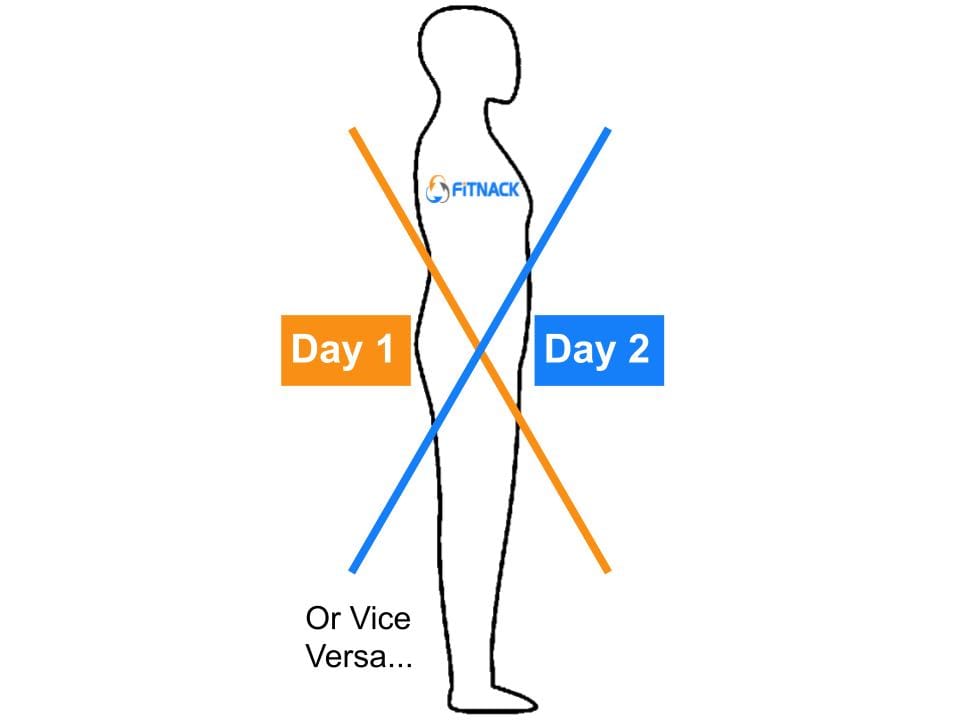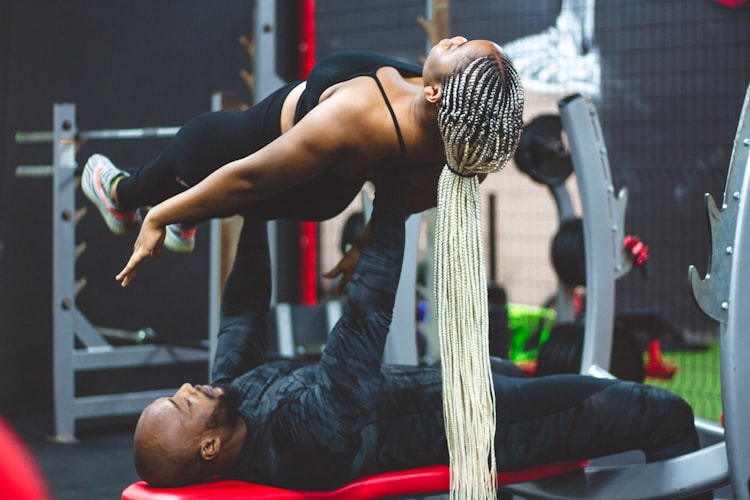The X Split Routine

This unique split pairs the front of the upper body with the back of the lower body with the back of the upper body with the front of the lower body.
I use an upper/lower split more than I use this, but it does have some unique quirks that I like for certain individuals with certain goals in certain situations. It's also a decent way to mix things up if you're bored.
Mostly, it's a way around getting a decent leg stimulus for people who hate leg day (lower body day) or who struggle with recovery. It spreads some of that stimulation out. I also like it with certain older individuals or for unique athletic endeavours.
Exercise selection, especially in the lower body, becomes a little trickier otherwise because of the amount of overlap, so you have to be more deliberate with scheduling.
This isn't a drop-in for an upper/lower split because it's tricky to productively implement on back-to-back days. Often this results in pairing an upper/lower with the X split: Mon/Tues, then Thur/Sat with the X pattern, so you get a day between the X split. Or it results in pairing this with 1 full body day, so that you can lift 3x a week but with a day off in between (e.g. M/W/F), but with better recovery.
A Brief History
I started experimenting with this split extensively in 2009-2012 with my athletes. The head coach of the football team I was working with at the time wanted a lot of Olympic lift training in the routines. Something I didn't fully agree with, but also wasn't worth pushing back too much on.
So the first off-season, I did what most coaches do, and I put the Olympic lifts on lower body days, but pretty soon, I could tell shoulders were getting beat up. I've found that the lower body handles these lifts just fine. It's the shoulders that start to get cranky with all the catches (snatch or cleans, or jerks), especially with athletes who aren't built for these lifts.
Now, a lot of those athletes just end up with different lift assignments (swings usually and lots of plyos), but managing individualization for 80 athletes is tough, especially when you only have 2 interns helping.
Anyway, I started exploring some ways to lighten that perceived recovery problem and kind of stumbled across this as an idea. I don't want to take credit for its existence. I'm sure I read about it somewhere or got the idea from somewhere else, and I simply can't recall. This post has been live for almost a decade now, and no one has reached out to tell me that I stole their idea, at least.
My first implementations were straight up replacements for traditional upper/lower, which led to other problems I'll discuss and why I've landed on what I do now.
But at the time, it felt like I stumbled across something exciting and new, and my athletes kind of dug it because it at least resolved the cranky shoulder issues in many of them. And it made the head coach of the team happy, so it all felt like a win-win.
The Name
Initially, I called it the LA-UP/LP-UA split. Yeah, that's a mouthful ...
Here is where those abbreviations come from, based on the anatomical locations of what you’re training:
- LA = Lower Anterior
- UP = Upper Posterior
- LP = Lower Posterior
- UA = Upper Anterior
- Upper = above the trunk
- Lower = below the trunk
- Anterior = the front of the body
- Posterior = the back of the body
Try to remember that when talking to athletes, and having them remember what you're talking about from session to session.
It didn't work that well.
It then became the upper pull/lower push and upper push/lower pull split, but again, kind of a mouthful.
I got fed up calling it that, too. It wasn't always truly posterior or truly anterior because of "anatomy," no matter how hard you tried. And it wasn't always pushing and pulling.
I drew a doodle on a piece of paper to articulate the concept to an athlete who was struggling with the idea, and noticed it created an X. Well, that's a lot easier to say. See image above for a digital representation ...
I've definitely never heard anyone refer to the X split, so I guess I can take credit for that.
The Original Implementation
Football players like to push (bench press being a favourite), and they like to power clean.
Add a jerk or a push press into the mix (the second part of a clean), and you end up with a hamstring/glute exercise (primary movers in the clean) with a bit of a back stimulus (the high pull) and then shoulder/tricep for the push press.
You can modulate this effect by programming intensity ranges (% of 1RM), but young men never want to follow those. Most of the time, what you can jerk ends up being less than what you can clean (often a lot less). Some coaches put the jerk on a separate day (upper body day) to work around this, but if athletes did a clean (or snatch) the previous day, that's still a lot of shoulder work.
Remember, these football athletes were still doing a bunch of technical training, even in the off-season, so lots of pushing drills, sprinting, etc ...
A lot of this was really about getting the Olympic lifting on the same days twice a week, so they had lots of recovery between those sessions. It kind of evolved into snatch one day (typically power snatch with a clean-grip), with bench pressing and a power clean and with a jerk (maybe push press) of some kind, the other day.
The other problem with Olympic lifting in that context was that, depending on the catch, there could be more squatting than you might want (full clean vs power clean), so I resolved that by just doing power everything. Again, not training Olympic lifters, and these lifts are already so hamstrings/glute dominant, I didn't want to add squats on the same day. Thus, squats (and other quad/glute-focused) exercises tended to end up on the next day.
So squats and pullups and/or rows were kind of the main events on day 2, and the glutes weren't in too bad a shape that day, so they could tolerate it because the snatching or cleans were often submaximal and the supportive work on day 1 was hamstring-focused.
Day 1
- Knee or Quad Dominant Moves (Anterior Lower Body)
- Upper Body Pulling Moves (Posterior Upper Body)
Day 2
- Hamstring (sometimes Hip or Glute) Dominant Moves (Posterior Lower Body)
- Upper Body Pushing Moves (Anterior Upper Body)
Often, these would be back-to-back days at that time, like so:
- Monday - X split 1 (or 2)
- Tuesday - X split 2 (or 1)
- Thursday - X split 1 (or 2)
- Saturday - X split 2 (or 1)
That might look like something like this:
Day 1
- A) Power Clean (3-5 reps)
- B1) Hip Hinge (4-6 reps)
- B2) Bench Press (4-6 reps)
- C1) Nordics or Hamstring Curl [maybe a Single Leg Bridge or Hip Hinge] (8ish reps)
- C2) Incline/Overhead Press (8ish reps)
- Then any accessory or isolation work the athlete wanted from a smorgasbord of offerings that followed the same principles… anterior shoulder/middle shoulder, triceps, calves
Day 2:
- A) Squat (3-5 reps or so)
- B1) Side Lunge Variation or Leg Press (maybe 5-8 reps)
- B2) Chin Up (Max reps typically put people in a 6-12 rep range)
- C1) Leg Extension, Reverse Nordics or heel-raised step-ups (8ish reps)
- C2) Row (6-10 reps), maybe a Facepull (10-12 reps)
- Then any accessory or isolation work the athlete wanted from a smorgasbord of offerings that followed the same principles… posterior shoulders, arm flexion, hip flexors, rotator cuff stuff, that kind of thing ...
It's not bad, actually, but I later decided that while better than upper/lower for the shoulders, the glutes/hips were now getting overworked. They could just handle it better, so the problems took longer to show.
Which led to what I do now.
Some machines weren't always available; the gym kind of evolved while I was there into a very well-outfitted gym that it is today. It started with me training out of a visitor's locker room under a football stadium, though.
The Problems
The most obvious problem is that most compound quad work is also compound glute work, and most compound hamstring work is also compound glute work. But at least the hips are more robust than the shoulders.
I still call it the X split, because I don't even know how to frame it otherwise. But the lower body part of the X now refers directly to a quad emphasis and a hamstring emphasis, knowing that the glutes are probably going to get hit in both of those training days.
What makes people sore from o-lifting in the back muscles is typically dropping the weight back to their waist without dropping it. So we started encouraging everyone to drop the weight. Not something everyone can do in every gym, but we had lifting platforms and bumper plates, so we could.
There were also issues with rotation and frontal plane training, which I like to keep in the mix for athletic populations. I settled on most of that going on the upper body pull/lower body push days, mostly because it was so completely different from the sagittal plane O-lifting they were doing the other days.
There would also be contrast training I'd introduce (instead of or in addition to the Olympic lifting) that was tricky to program within this schedule, but it's a problem for upper/lower too.
What I do Now
The biggest change I made was that I never use this split in isolation anymore, and I always give people a day off between X days. It evolved into something like this:
- Monday - Lower (or upper)
- Tuesday - Upper (or lower)
- Thursday - X split 1 (or 2)
- Saturday - X split 2 (or 1)
Or
- Monday - X split 1 (or 2)
- Wednesday - X split 2 (or 1)
- Friday - Lower (or upper)
- Saturday - Upper (or lower)
Which is also a good way to break up an upper/lower, especially if you've got some pretty intensive lower body training days.
This ultimately led to a kind of the best of both worlds, where the limitations of each split (upper/lower and X) even out a bit.
Thursday could be the heavier or more intensive Olympic lifting day. Saturday would be kind of a lighter quad focus with some pulling. Lower would just have power cleans ahead of heavier, more pure strength work for the lower body. And upper could be kind of the bench day focus that everyone loved.
Away from athletics, I now often use this split like this:
- Monday - Full Body
- Wed(or Thur) - X split 1 (or 2)
- Fri (or Sat) - X split 2 (or 1)
But because a lot of these clients don't Olympic lift, it really just allows me to break up the lower body into 2 different days in the week while hitting everything twice a week. Recovery improves, especially if you're over 45, but you don't have to go to an upper/lower split every other day (which makes it a 2-week cycle).
That full-body becomes the more technical, athletic, but lower-volume training day, where if someone does any Olympic lifting (or plyos), they are on that day. Kind of more of a compound focus, and the X split becomes more strength/bodybuilding focused in many cases.
It kind of depends on priorities, but having used this split for a while now, I'm convinced you can't run it on back-to-back days the way you can an upper/lower, which is why I still default to upper/lower depending on the schedules of my clients.
Mostly, that's because it's really hard to remove the glutes from the quad work and the hamstring work, but there is some overlapping upper body stuff that can get weird sometimes, too.
I don't use it as much as upper/lower or full body training, which tend to be my go-tos, but I've also never seen anyone talk much about it or coined it before so I figured I would.
When to Use It
This is a far cry from traditional — and somewhat wacky — bodybuilding splits that view things in terms of muscles.
Honestly, I rarely use bodypart splits anymore, even for hypertrophy programs, unless there is a specialization reason to do it…
I love full-body training (always have), but it rarely works 3x a week beyond beginner phases with really low volumes or for maintenance purposes. 3x a week just isn't handled well once you get strong, and the warm-ups eat up a bunch of the time you are training. I use it all the time, especially if you can only train twice a week, it's kind of the only good option. Mixing it is best, though, and I often do with an upper/lower split (same as the X split approach I drew out above).
It’s also very different from a traditional upper/lower (UL) split, which is still my go-to even if it isn't perfect. It's arguably the most effective split for intermediate to advanced lifters who aren't simply maintaining.
Some additional reasons why I might not use an UL, though:
- UL splits can sometimes tend to beat up very specific parts of the body, especially the legs, if you try to round out that day with similar volumes to the upper body
- This was especially true when using more muscle-building phases of training, with moderate intensity and moderate reps, less so with lower volume strength-specific programs
- It can be harder to use paired sets with UL splits, though, mostly only a problem in the lower body
- UL splits don’t seem to be as applicable for body composition (fat loss) objectives (but I'm usually reducing total volume on these anyway)
- UL splits can make it a bit hard to program certain lifts (for example, Olympic lifting — though I know a lot of coaches just put them on lower body days…)
Fundamentally, I think you should try the X split if:
- Leg days or lower body days often feel hard for you, and that causes you to avoid them.
- You are doing some Olympic lifting in your routine ...
- You like paired sets and can do them where you train with ease
- You can only train 3x a week, and you're not a beginner (put it with one full-body day)
- You can train 4x a week, but you have more athletic goals (pair it with an upper/lower split on 2 other days and make sure you can get the extra day off between X days)
- If you can't follow that schedule, you can do it back-to-back but get 2 days rest after the X part of the routine and pair with an upper/lower split to manage the excessive glute work that results
- Don't have any training sessions on back-to-back days (upper/lower is better for that, in my opinion)
Using the X Split with Twin Pairing Training
Now, assuming you’re not a football player and you’re a fan of the paired set style of training I introduced in the 2×2 Training Framework (TPT or Twin Pairing System), your program should look a little bit different.
What you see above probably sounds complicated, but what it resulted in is quite simple.
In the 2×2 training framework, I discussed the concept of paired sets, and for 2×2 training, you use 2 paired sets of exercises for a total of only 4 exercises.
That idea can easily extend to the X Split Routine; it just gets spaced out differently.
Day 1 (LA/UP)
- A1) Bilateral Knee/Quad Dominant Lift (Probably a Squat…)
- A2) Vertical Pull (Chin Up Variation)
- B1) Unilateral Knee/Quad Dominant Lift (Probably a Lunge or Step Up…)
- B2) Horizontal Pull (Row Variation)
Day 2 (LP/UA)
- A1) Bilateral Hip/Glute Dominant Lift (Probably a hip hinge …)
- A2) Horizontal Push (Bench/Push Up Variation)
- B1) Unilateral Hip/Glute Dominant Lift (Probably a Loaded Glute Bridge or Single Leg Deadlift)
- B2) Vertical Push (Incline Bench or Overhead Press Variation)
Honestly, from there, you can add accessory movement after the fact if you think you need it. Calves and arm flexors on the lower body push, upper pull day, for example. Arm extensors and anterior shoulder on lower body pull, upper body push day, as another example.
Pairing helps reduce the length of a training session, so you can often get the above done in about 30 minutes, often including your warm-up.
Anyway, give that a try if you can’t train full body and let me know how it goes in the comments.




